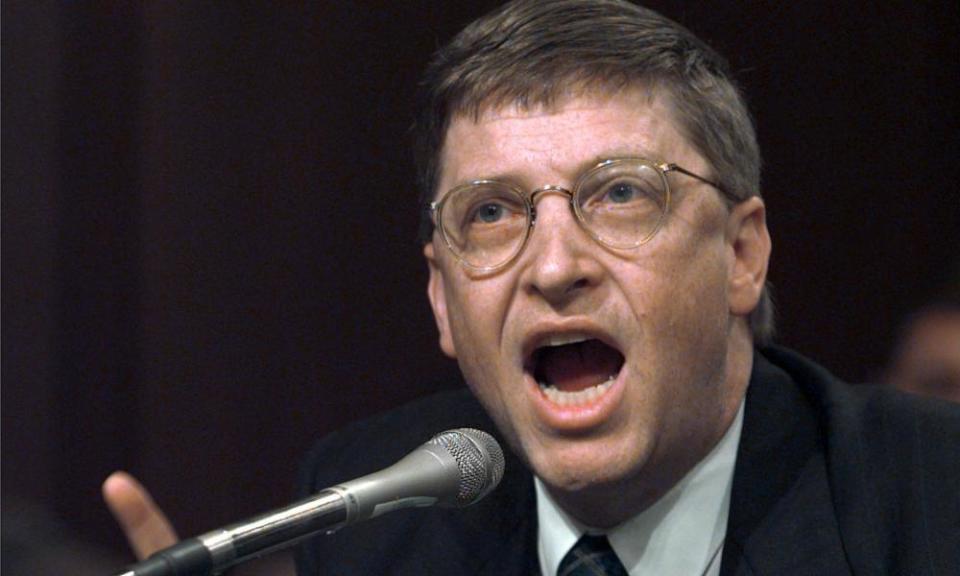Let's not forget, Bill Gates hasn't always been the good guy…

Twenty five years ago last Monday, Microsoft released Windows 95, its first operating system based on the Wimp (Windows, Icons, Menus, Pointer) interface that had been developed at Xerox PARC in the early 1970s and, er, borrowed by Steve Jobs for the Apple Macintosh that he launched in 1984.
Few geeks who were around and sentient at the time will forget the hoop-la that surrounded the launch of the Microsoft system. It included a commercial that had the Rolling Stones’ Start Me Up as a soundtrack. The symbolism of this was that in order to get Win95 rolling you had to press the “Start” button. (Satirists quickly noted that in order to turn the operating system off you also had to press the Start button, but the joke was clearly lost on Microsoft’s designers.) It was variously reported that the company had paid the Stones between $8m and $14m for the right to use the song, but Microsoft said that this was just a rumour spread by the band to increase their market value, and that the company actually paid a fraction of that amount.
The geek community, which was – then as now – sceptical of the Microsoft juggernaut, viewed the hoop-la with a certain ironic detachment. Some observed that it had taken the company 11 years to catch up with Apple, or 22 years to catch up with PARC. But the most interesting aspect of the launch was the evidence it provided that even in 1995 Microsoft had not yet fully twigged the significance of the internet. The first version of the standard pack installation of Win95, for example, did not include either a web browser or the TCP/IP stack required to connect a PC to the net. The stack was available in an add-in pack from which users could install it themselves, and the first version of the Internet Explorer browser didn’t come until the first update of Win95.
A lot of computing history hangs on that fateful omission. We later found out that in May 1995 Bill Gates, then the CEO, had had his “Oh shit!” moment about the internet. On 26 May he sent out a famous long memo to all executive staff in the company. It was headed “The Internet Tidal Wave” and in it Gates made it abundantly clear that the company had to pivot immediately to address the existential threat the network represented.
“One scary possibility being discussed by internet fans,” he wrote, “is whether they should get together and create something far less expensive than a PC which is powerful enough for web browsing.” Given that Microsoft’s monopoly was built on the PC, this would be a really big deal. He pointed out that after 10 hours of browsing the internet, he “had not seen a single Word.doc, AVI file, Windows.exe (other than content viewers), or other Microsoft file format”. He did, however, see “a great number of QuickTime files” and declared his determination to “match or beat” the services offered by Netscape, a “competitor ‘born’ on the internet” which at the time was claiming to have a 70% share of the web-browser market.
We know what then happened: Microsoft did indeed pivot to confront the threat. Gates and co set out to destroy Netscape before it could mature into the existential threat he had foreseen. And the campaign succeeded; Netscape was destroyed – though before it died it open-sourced its Netscape browser code, thereby enabling the founding of Mozilla, the free software community that now produces Firefox. Microsoft’s Internet Explorer became the dominant web browser – mainly because every copy of Windows came with it installed by default.
So although Gates’s consummate ruthlessness in eliminating Netscape succeeded, it also nearly destroyed Microsoft. In 1998, the US Department of Justice sued it for illegally thwarting competition and for compelling computer makers to include its internet browser when installing Windows. The initial judgment in the case – that Microsoft should be broken up – was overturned on appeal and in 2001 the George W Bush administration sought a lesser antitrust penalty and agreed a deal with the company. But it was a close-run thing.
The most striking things I remember from the case were the recordings of Gates’s depositions under oath in which he was consistently truculent, evasive and non-responsive – to the point where his sheer obstructiveness sometimes made the trial judge laugh. They show a mogul who is incredulous that the government would dare to obstruct his route to world domination. The tapes confirm how obnoxious and aggressive Gates was at that point in his life (he was 43). And the question they prompt is this: how did this sullen and dismissive businessman morph into the generous, enlightened, public-spirited philanthropist we see today? If such a transformation can happen to the Bill Gates of old, then surely it can happen to anyone. Well, almost anyone: in the week of the Republican convention, one shouldn’t get carried away.
What I’ve been reading
Picking locks with audio technology
This article by Paul Marks in the 13 August edition of Communications of the ACM is interesting or alarming, depending on your point of view.
Stefan Collini on the enigma that was Frank Kermode
Lovely essay by Stefan Collini in the London Review of Books on a critic we were both fortunate enough to have known.
Trump’s shot at a second term
“Inside the chaotic, desperate, last-minute Trump 2020 reboot.” Great piece of reportage by Olivia Nuzzi in New York Magazine.

